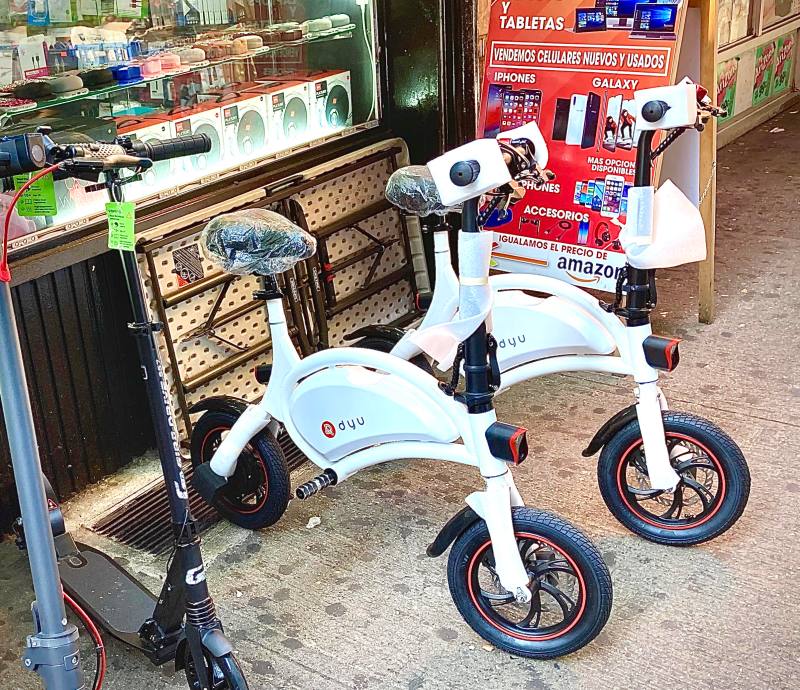Read The Full Article On: Nyc
A cute, new micro-mobility device (the DYU D1F, pictured above) illustrates why New York State’s outdated Vehicle and Traffic Law desperately needs updating in order to bring it into the 21st century.
That’s not an academic exercise — it’s indicative of a bad situation in which thousands of New Yorkers, many of them low-wage, immigrant workers, are needlessly at risk of police encounters and harassment because of the illegality of the vehicles that are essential to their livelihoods.
After much struggle, New York recently passed a (somewhat flawed) law authorizing the use of e-bikes and e-scooters, but many two-wheeled, electric-powered vehicles technically remain illegal … for no good reason. The legislature needs to come together to fix the situation — and soon.
How’s that?
Consider the DYU D1F — which is just one of many newfangled micro-mobility devices that have come recently to market. A two-wheeled, electric-powered device that’s just over three feet long, it may look like a toy, but it can do 15 miles an hour for a range of 12 miles (so it could take you the length of Manhattan, for example).
Like many new micro-mobility implements, the DYU D1F is hard to classify. It lacks “operable pedals,” so it’s not an e-bike. Instead, it’s considered a motor vehicle — specifically, a limited-use motorcycle. But you can’t register it at the Department of Motor Vehicles, because it lacks a “factory number” (also known as a Vehicle Identification Number). So, you can’t register it and, therefore, you can’t legally operate it on the street.
Doing so would subject you to ticketing, fines, and even impoundment of your vehicle. That’s true of many of the non-conforming, limited-use motorcyclesnow being operated in New York City by low-wage, immigrant workers.
Albany needs to come up with a coherent policy framework for low-speed motorized vehicles rather than segmenting them into so many boxes: e-bikes, e-scooters, limited-use motorcycles, and so on.
This framework needs to honor the fact that a set of bicycle pedals don’t say anything by itself about whether innovative, space-saving, quiet electric vehicles belong on our streets — just like having a driver’s license doesn’t by itself make someone a safe car operator.
New York laws shouldn’t punish the users of low-speed vehicles while giving free rein to large, four-wheeled, motorized boxes — i.e. cars — just because they have “factory numbers.”
No one can make a legitimate safety, street space, or environmental argument for why a small electric vehicle should be illegal just because it lacks pedals and a license plate.
The DYU D1F is in the same weight and speed range as e-bikes — so it’s surely not more dangerous than an e-bike. It’s substantially smaller than most e-bikes, so surely street space isn’t the problem. It has built-in front and rear headlights and comes in white, so surely visibility isn’t the problem. It even has front and rear disc brakes, so surely stopping performance isn’t the problem. It’s also slow, so carnage isn’t the problem.
And, as I mentioned, it’s electric — so, surely, noise and air emissions aren’t the problem.
People haven’t figured out what to call the DYU D1F colloquially — a “smart electric bike” (as its manufacturer calls it)? A sit-down scooter? A moped without the “ped”? An “e-thing”? It has many nifty features: The handlebar folds down. It’s got a cutout so you can carry it with one hand. Given these features, the maker of the DYU D1F clearly is targeting commuters. With no carrying capacity or a rack, it’s unlikely that a delivery worker would use it, but make no mistake — many delivery-worker vehicles occupy the same legal gray area.
You can buy a DYU D1F for about $700 — but where are you supposed to ride it?
Albany: Fix this problem and save thousands of hard-working New Yorkers from over-policing.

